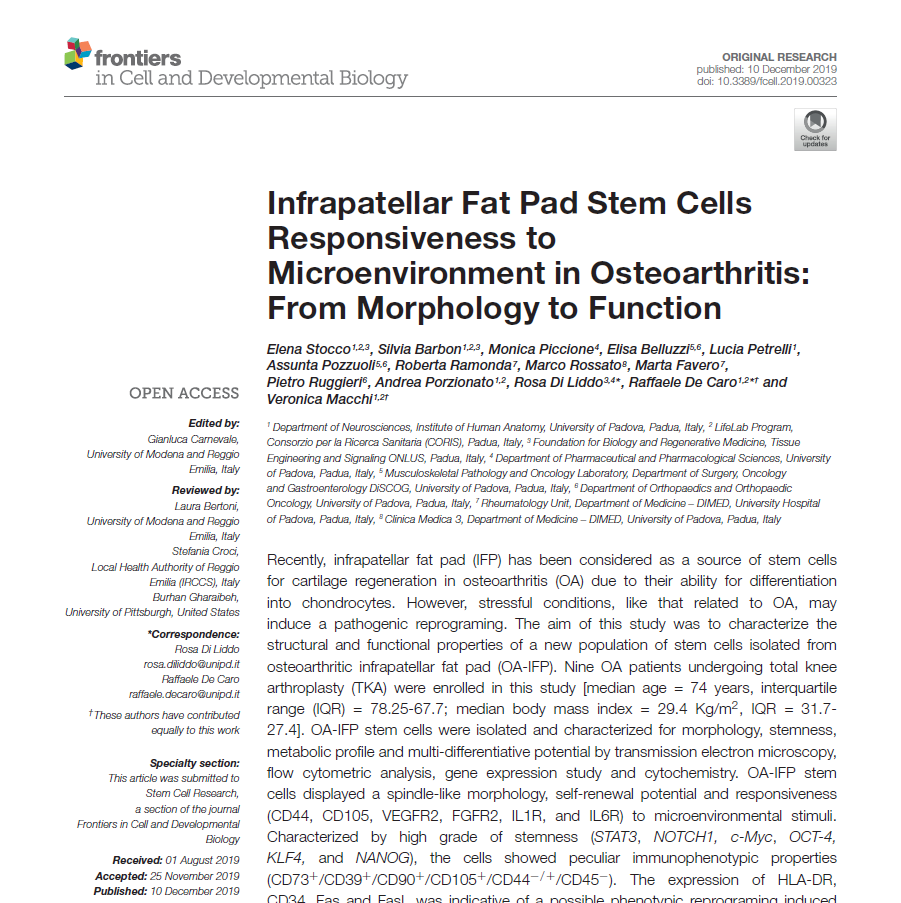
- February 25, 2020
Infrapatellar Fat Pad Stem Cells Responsiveness to Microenvironment in Osteoarthritis: From Morphology to Function
Elena Stocco, Silvia Barbon, Monica Piccione, Elisa Belluzzi, Lucia Petrelli, Assunta Pozzuoli, Roberta Ramonda, Marco Rossato, Marta Favero, Pietro Ruggieri, Andrea Porzionato, Rosa Di Liddo, Raffaele De Caro and Veronica Macchi |Department of Neurosciences, Institute of Human Anatomy, University of Padova, Padua, Italy, LifeLab Program, Consorzio per la Ricerca Sanitaria (CORIS), Padua, Italy, Foundation for Biology and Regenerative Medicine, Tissue Engineering and Signaling ONLUS, Padua, Italy, Department of Pharmaceutical and Pharmacological Sciences, University of Padova, Padua, Italy, Musculoskeletal Pathology and Oncology Laboratory, Department of Surgery, Oncology and Gastroenterology DiSCOG, University of Padova, Padua, Italy, Department of Orthopaedics and Orthopaedic Oncology, University of Padova, Padua, Italy, Rheumatology Unit, Department of Medicine DIMED, University Hospital of Padova, Padua, Italy, Clinica Medica 3, Department of Medicine DIMED, University of Padova, Padua, Italy |2019|Frontiers in Cell and Developmental Biology; 7:323. doi: 10.3389/fcell.2019.00323
Osteoarthritis (OA) is a condition that affects the whole joint including bone, cartilage, ligaments and muscles. It has been recently observed that infrapatellar fat pad (IFP) may play a multifunctional role in knee joint homeostasis by being a source of stem cells for cartilage regeneration, however stressful conditions such as osteoarthritis may induce a pathogenic reprogramming of these stem cells. The aim of this study was to characterize the structural and functional properties of a new population of stem cells isolated from osteoarthritic infrapatellar fat pad (OA-IFP). OA-IFP stem cells were isolated and characterized for morphology and stemness. The long-term proliferative potential and metabolic activity were then determined where genes related to stemness and metabolic activity of OA-IFP stem cells were characterized. A gene expression study, using these identified genes, was carried out by a single step RT-qPCR on the Magnetic Induction Cycler (MIC) to determine their links to OA-OFP. The gene expression study was carried out by a single step RT-qPCR on a Magnetic Induction Cycler (MIC). Based on the functional characterization, OA-IFP stem cells were hypothesized to be primed by the pathological environment and to exert incomplete protective activity from OA inflammation.
Read More